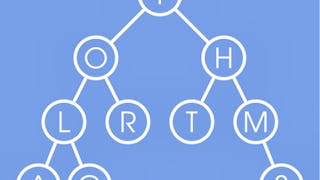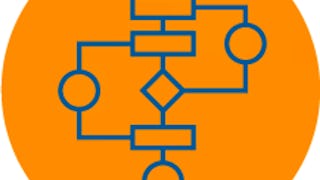Comment les programmes Java gèrent-ils de grandes quantités de données ? Beaucoup de structures de données et d'algorithmes qui fonctionnent avec des exemples de jouets d'introduction se cassent la figure lorsque les applications traitent des ensembles de données réels et volumineux. L'efficacité est essentielle, mais comment l'atteindre et comment la mesurer ? Ce cours est un cours intermédiaire sur Java. Nous recommandons ce cours aux apprenants qui ont une expérience préalable dans le développement de logiciels ou une formation en informatique, et en particulier, nous vous recommandons d'avoir suivi le premier cours de cette spécialisation (qui nécessite également une certaine expérience préalable avec Java).

Fin dans 3 jours. Donnez un coup de fouet à votre carrière en bénéficiant de 40 % de réduction sur les cours d'Adobe, d'IBM et d'autres. Économisez maintenant.


Structures de données et performances
Ce cours fait partie de plusieurs programmes.



Instructeurs : Christine Alvarado
108 404 déjà inscrits
Inclus avec 
(2,233 avis)
Compétences que vous acquerrez
- Catégorie : Programmation Informatique
- Catégorie : Programmation orientée objet (POO)
- Catégorie : Programmation Java
- Catégorie : Débogage
- Catégorie : Algorithmes
- Catégorie : structures de données
- Catégorie : Optimisation des performances
- Catégorie : Tests unitaires
- Catégorie : Tests de développement
- Catégorie : Science Informatique Théorique
- Catégorie : Test de logiciels
Détails à connaître

Ajouter à votre profil LinkedIn
16 devoirs
Découvrez comment les employés des entreprises prestigieuses maîtrisent des compétences recherchées

Élaborez votre expertise du sujet
- Apprenez de nouveaux concepts auprès d'experts du secteur
- Acquérez une compréhension de base d'un sujet ou d'un outil
- Développez des compétences professionnelles avec des projets pratiques
- Obtenez un certificat professionnel partageable

Il y a 6 modules dans ce cours
Bienvenue au premier module du deuxième cours de notre spécialisation en programmation Java intermédiaire. Nous commencerons par nous présenter à nouveau : nous-mêmes, les ingénieurs de Google et la structure du cours. Après l'introduction, nous ferons un petit échauffement pour vous mettre à l'aise avec le code que vous allez construire dans ce cours. Mais ne vous inquiétez pas, il n'y a pas encore de devoirs de programmation notés. Cette semaine a pour but de vous mettre à l'aise et de vous donner envie d'apprendre.
Inclus
7 vidéos9 lectures3 devoirs
Cette semaine, nous allons nous plonger dans le projet de programmation du cours. Dans la première leçon, vous apprendrez ce que sont les chaînes de caractères et les expressions régulières, et dans le devoir de programmation de cette semaine, vous appliquerez ces connaissances en ajoutant une fonctionnalité à votre éditeur de texte afin qu'il puisse mesurer la "lisibilité" du texte en calculant ce que l'on appelle le "score de lisibilité de Flesch". Ce cours se concentre sur la construction d'un code qui non seulement fait des choses intéressantes, mais les termine également rapidement. Alors, commençons à construire du code !
Inclus
15 vidéos6 lectures3 devoirs1 devoir de programmation1 sujet de discussion
Bienvenue à la troisième semaine ! L'application d'édition de texte avec laquelle vous avez travaillé la semaine dernière fait quelque chose, mais elle ne le fait pas particulièrement vite. Cette semaine, nous allons commencer à parler d'efficacité. Nous introduirons le concept de notation "Big-O", qui semble un peu ridicule, mais qui est en réalité un moyen puissant (et extrêmement courant) d'analyser l'efficacité d'un programme, indépendamment du système sur lequel il s'exécute et des détails exacts de la façon dont il est implémenté. Ensuite, nous irons dans l'autre sens et nous plongerons dans les détails, en expliquant comment mesurer le temps d'exécution réel d'un morceau de code pour avoir une idée de ses performances réelles dans la pratique.
Inclus
25 vidéos3 lectures4 devoirs1 devoir de programmation
Cette semaine, nous allons commencer à aborder certains des concepts de base que l'on s'attend à trouver dans un cours sur les structures de données : l'idée d'abstraction de données et une structure de données appelée liste liée. Bien que les listes liées ne soient pas des structures très efficaces (pour la plupart), elles mettent en évidence l'idée de "relier" des éléments de données dans la mémoire de votre ordinateur, plutôt que de stocker les données dans une région contiguë. Cette idée de liaison sera au cœur de nombreuses structures de données plus avancées, à savoir les arbres et les graphes, qui seront abordées plus tard dans ce cours et dans le prochain cours de cette spécialisation. Dans ce module, vous apprendrez également des outils et des procédures pour tester votre code à l'unité, ce qui est un moyen de s'assurer que ce que vous avez écrit est correct, et une pratique de base de tout développeur de logiciel sophistiqué.
Inclus
26 vidéos3 lectures3 devoirs2 devoirs de programmation
Bienvenue à la semaine 4 ! Nous savons que vous avez travaillé dur. Nous espérons que vous avez essayé le travail de programmation optionnel de génération de texte de Markov la semaine dernière, mais si ce n'est pas le cas, ne vous inquiétez pas. Vous pouvez toujours y retourner et le faire plus tard (alerte spoiler : il est assez étonnant qu'un algorithme aussi simple puisse produire un texte aussi réaliste). Cette semaine, nous allons nous amuser (et travailler dur) en apprenant ce que sont les arbres. Les arbres reposent sur la même idée de structure liée que les listes liées, mais ils sont BEAUCOUP plus rapides (en général...). Dans le projet de cette semaine, vous ajouterez l'auto-complétion à votre éditeur de texte. Croyez-nous quand nous vous disons que c'est vraiment génial quand ça marche ! Vous verrez... et nous parions que vous ne pouvez plus attendre le travail de programmation :)
Inclus
22 vidéos3 lectures2 devoirs1 devoir de programmation
Vous avez atteint la dernière semaine ! Félicitations pour être arrivé jusqu'ici ! Au cours de cette dernière semaine, nous allons étudier une structure de données fondamentale appelée table de hachage. Si vous pensiez que les arbres étaient rapides, attendez de voir ce que les tables de hachage peuvent faire ! Votre dernier travail de programmation ajoutera des suggestions de correction orthographique à votre éditeur de texte, et il y a un travail optionnel qui s'appuie sur les mêmes idées que le travail principal, si vous avez le temps et l'énergie.
Inclus
14 vidéos3 lectures1 devoir2 devoirs de programmation
Obtenez un certificat professionnel
Ajoutez ce titre à votre profil LinkedIn, à votre curriculum vitae ou à votre CV. Partagez-le sur les médias sociaux et dans votre évaluation des performances.
Instructeurs



Offert par
En savoir plus sur Algorithmes
 Statut : Essai gratuit
Statut : Essai gratuitUniversity of California San Diego
 Statut : Essai gratuit
Statut : Essai gratuit Statut : Essai gratuit
Statut : Essai gratuit Statut : Essai gratuit
Statut : Essai gratuit
Pour quelles raisons les étudiants sur Coursera nous choisissent-ils pour leur carrière ?




Avis des étudiants
2 233 avis
- 5 stars
82,36 %
- 4 stars
14,54 %
- 3 stars
1,88 %
- 2 stars
0,44 %
- 1 star
0,76 %
Affichage de 3 sur 2233
Révisé le 16 janv. 2017
A very good course for beginners , people having prior knowledge about data structures might found it a bit easy , anyways the projects were fun and was course was worth taking
Révisé le 18 sept. 2016
Brilliant course. Learnt a lot about Data Structures like Trees, Tries, HashMaps etc. The best part was implementing the back-end for the text-editor project. Highly recommend it.
Révisé le 19 nov. 2017
Very helpful course in helping to understand data structures and algorithms. This course will certainly prepare me well for my university degree in computer science

Ouvrez de nouvelles portes avec Coursera Plus
Accès illimité à 10,000+ cours de niveau international, projets pratiques et programmes de certification prêts à l'emploi - tous inclus dans votre abonnement.
Faites progresser votre carrière avec un diplôme en ligne
Obtenez un diplôme auprès d’universités de renommée mondiale - 100 % en ligne
Rejoignez plus de 3 400 entreprises mondiales qui ont choisi Coursera pour les affaires
Améliorez les compétences de vos employés pour exceller dans l’économie numérique
Foire Aux Questions
L'accès aux cours et aux devoirs dépend de votre type d'inscription. Si vous suivez un cours en mode audit, vous pourrez consulter gratuitement la plupart des supports de cours. Pour accéder aux devoirs notés et obtenir un certificat, vous devrez acheter l'expérience de certificat, pendant ou après votre audit. Si vous ne voyez pas l'option d'audit :
Il se peut que le cours ne propose pas d'option d'audit. Vous pouvez essayer un essai gratuit ou demander une aide financière.
Le cours peut proposer l'option "Cours complet, pas de certificat" à la place. Cette option vous permet de consulter tous les supports de cours, de soumettre les évaluations requises et d'obtenir une note finale. Cela signifie également que vous ne pourrez pas acheter un certificat d'expérience.
Lorsque vous vous inscrivez au cours, vous avez accès à tous les cours de la Specializations, et vous obtenez un certificat lorsque vous terminez le travail. Votre certificat électronique sera ajouté à votre page de réalisations - de là, vous pouvez imprimer votre certificat ou l'ajouter à votre profil LinkedIn. Si vous souhaitez uniquement lire et visualiser le contenu du cours, vous pouvez auditer le cours gratuitement.
Si vous vous êtes abonné, vous bénéficiez d'une période d'essai gratuite de 7 jours pendant laquelle vous pouvez annuler votre abonnement sans pénalité. Après cette période, nous ne remboursons pas, mais vous pouvez résilier votre abonnement à tout moment. Consultez notre politique de remboursement complète.
Plus de questions
Aide financière disponible,

